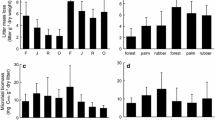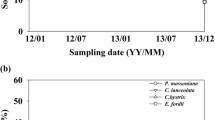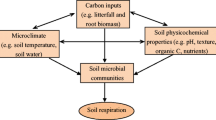Abstract
Focusing on Sumatra, a hotspot of tropical lowland rainforest transformation, we investigated effects of the conversion of rainforests into rubber agroforests (“jungle rubber”), intensive rubber, and oil palm plantations on the communities of litter and soil microorganisms and identified factors responsible for these changes. Litter basal respiration, microbial biomass, total bacterial phospholipid fatty acids (PLFAs), and fungal PLFAs did not vary significantly with rainforest conversion. In litter of converted ecosystems, the concentration of certain PLFAs including the Gram-negative bacteria marker PLFA cy17:0 and the Gram-positive bacteria marker PLFA i17:0 was reduced as compared to rainforest, whereas the concentration of the arbuscular mycorrhizal fungi (AMF) marker neutral lipid fatty acid (NLFA) 16:1ω5c increased. As indicated by redundancy analysis, litter pH and carbon concentration explained most of the variation in litter microbial community composition. In soil, microbial biomass did not vary significantly with rainforest conversion, whereas basal respiration declined. Total PLFAs and especially that of Gram-negative bacteria decreased, whereas PLFA i17:0 increased with rainforest conversion. The concentration of fungal PLFAs increased with rainforest conversion, whereas NLFA 16:1ω5c did not change significantly. Redundancy analysis indicated that soil pH explained most of the variation in soil microbial community composition. Overall, the data suggest that conversion of rainforests into production systems results in more pronounced changes in microbial community composition in soil as compared to litter. In particular, the response of fungi and bacteria was more pronounced in soil, while the response of AMF was more pronounced in litter. Notably, only certain bacterial markers but not those of saprotrophic fungi and AMF were detrimentally affected by rainforest conversion.



Similar content being viewed by others
References
Allen E, Allen M, Helm D, Trappe J, Molina R, Rincon E (1995) Patterns and regulation of mycorrhizal plant and fungal diversity. Plant Soil 170:47–62
Anderson JPE, Domsch KH (1978) A physiological method for the quantitative measurement of microbial biomass in soils. Soil Biol Biochem 10:215–221
Aristizabal C (2008) Arbuscular mycorrhizal fungi enhance the acquisition of mineral nutrients from leaf litter by Morella cerifera. PhD, University of Miami, Coral. Open Access Dissertations, paper 94
Bååth E, Anderson T-H (2003) Comparison of soil fungal/bacterial ratios in a pH gradient using physiological and PLFA-based techniques. Soil Biol Biochem 35:955–963
Baldrian P (2014) Distribution of extracellular enzymes in soils: spatial heterogeneity and determining factors at various scales. Soil Sci Soc Am J 78:11
Barnes AD, Jochum M, Mumme S, Haneda NF, Farajallah A, Widarto TH, Brose U (2014) Consequences of tropical land use for multitrophic biodiversity and ecosystem functioning. Nat Commun 5:5351
Borneman J, Triplett E (1997) Molecular microbial diversity in soils from eastern Amazonia: evidence for unusual microorganisms and microbial population shifts associated with deforestation. Appl Environ Microbiol 63:2647–2653
Brussaard L, Behan-Pelletier VM, Bignell DE, Brown VK, Didden W, Folgarait P, Fragoso C, Wall Freckman D, Gupta VVSR, Hattori T, Hawksworth DL, Klopatek C, Lavelle P, Malloch DW, Rusek J, Söderström B, Tiedje JM, Ross AV (1997) Biodiversity and ecosystem functioning in soil. Ambio 26:563–570
Carney KM, Matson PA, Bohannan BJM (2004) Diversity and composition of tropical soil nitrifiers across a plant diversity gradient and among land-use types. Ecol Lett 7:684–694
Chapin S, Matson PA, Vitousek P (2012) Principles of terrestrial ecosystem ecology. Springer, New York
Cole LES, Bhagwat SA, Willis KJ (2014) Recovery and resilience of tropical forests after disturbance. Nat Commun 5:3906
Damayanti ND, Rini MV, Evizal R (2015) Growth response of oil palm seedling (Elaeis guineensis Jacq.) to give five types of arbuscular mycorrhizal fungi on two level NPK fertilize. J Penelitian Pertanian Terapan 15:33–40, (in Indonesian) ISSN 1410-5020
Feldmann F, da Silva Junior JP, Idczak E, Lieberei R (2000) AMF spore community composition at natural and agricultural sites in Central Amazonia - a long term study. Neotropical Ecosyst Hamburg, 669–682
Fierer N, Breitbart M, Nulton J, Salamon P, Lozupone C, Jones R, Robeson M, Edwards RA, Felts B, Rayhawk S, Knight R, Rohwer F, Jackson RB (2007) Metagenomic and small-subunit rRNA analyses reveal the genetic diversity of bacteria, archaea, fungi, and viruses in soil. Appl Environ Microbiol 73:7059–7066
Fitzherbert EB, Struebig MJ, Morel A, Morel A, Danielsen F, Brühl CA, Donald PF, Phalan B (2008) How will oil palm expansion affect biodiversity? Trends Ecol Evol 23:538–545
Frostegård A, Bååth E (1996) The use of phospholipid fatty acid analysis to estimate bacterial and fungal biomass in soil. Biol Fertil Soils 22:59–65
Frostegård A, Tunlid A, Bååth E (1993) Phospholipid fatty acid composition, biomass, and activity of microbial communities from two soil types experimentally exposed to different heavy metals. Appl Environ Microbiol 59:3605–3617
Frostegård Å, Tunlid A, Bååth E (2011) Use and misuse of PLFA measurements in soils. Soil Biol Biochem 43:1621–1625
Galindo-Castañeda T, Romero HM (2013) Mycorrhization in oil palm (Elaeis guineensis and E. oleifera x E. guineensis) in the pre-nursery stage. Agron Colomb 31:95–102, ISSN 0120-9965
García-Orenes F, Morugán-Coronado A, Zornoza R, Scow K (2013) Changes in soil microbial community structure influenced by agricultural management practices in a mediterranean agro-ecosystem. PLoS One 8, e80522
Gatto M, Wollni M, Qaim M (2015) Oil palm boom and land-use dynamics in Indonesia: the role of policies and socioeconomic factors. Land Use Policy 46:292–303
Geisseler D, Scow KM (2014) Long-term effects of mineral fertilizers on soil microorganisms – a review. Soil Biol Biochem 75:54–63
Giam X, Ng TH, Yap VB, Tan HTW (2010) The extent of undiscovered species in Southeast Asia. Biodivers Conserv 19:943–954
Gibbs HK, Ruesch AS, Achard F, Clayton MK, Holmgren P, Ramankutty N, Foley JA (2010) Tropical forests were the primary sources of new agricultural land in the 1980s and 1990s. Proc Natl Acad Sci U S A 107:16732–16737
Guillaume T, Muhammad D, Kuzyakov Y (2015) Losses of soil carbon by converting tropical forest to plantations: erosion and decomposition estimated by δ13C. Glob Chang Biol. doi:10.1111/gcb.12907
Jesus EC, Marsh TL, Tiedje JM, Moreira FM (2009) Changes in land use alter the structure of bacterial communities in Western Amazon soils. ISME J 3:1004–1011
Joergensen RG, Wichern F (2008) Quantitative assessment of the fungal contribution to microbial tissue in soil. Soil Biol Biochem 40:2977–2991
Kerekes J, Kaspari M, Stevenson B, Nilsson RH, Hartmann M, Amend A, Bruns TD (2013) Nutrient enrichment increased species richness of leaf litter fungal assemblages in a tropical forest. Mol Ecol 22:2827–2838
Koh LP, Ghazoul J (2010) Spatially explicit scenario analysis for reconciling agricultural expansion, forest protection, and carbon conservation in Indonesia. Proc Natl Acad Sci U S A 107:11140–11144
Koh LP, Miettinen J, Liew SC, Ghazoul J (2011) Remotely sensed evidence of tropical peatland conversion to oil palm. Proc Natl Acad Sci U S A 108:5127–51232
Krashevska V, Bonkowski M, Maraun M, Ruess L, Kandeler E, Scheu S (2008) Microorganisms as driving factors for the community structure of testate amoebae along an altitudinal transect in tropical mountain rain forests. Soil Biol Biochem 40:2427–2433
Krashevska V, Maraun M, Ruess L, Scheu S (2010) Carbon and nutrient limitation of soil microorganisms and microbial grazers in a tropical montane rain forest. Oikos 119:1020–1028
Krashevska V, Sandmann D, Maraun M, Scheu S (2012) Consequences of exclusion of precipitation on microorganisms and microbial consumers in montane tropical rainforests. Oecologia 170:1067–1076
Krashevska V, Sandmann D, Maraun M, Scheu S (2014) Moderate changes in nutrient input alter tropical microbial and protist communities and belowground linkages. ISME J 8:1126–1134
Lee-Cruz L, Edwards DP, Tripathi BM, Adams JM (2013) Impact of logging and forest conversion to oil palm plantations on soil bacterial communities in Borneo. Appl Environ Microbiol 79:7290–7297
Lekberg Y, Rosendahl S, Michelsen A, Olsson PA (2012) Seasonal carbon allocation to arbuscular mycorrhizal fungi assessed by microscopic examination, stable isotope probing and fatty acid analysis. Plant Soil 368:547–555
Lemanski K, Scheu S (2014) Incorporation of 13C labelled glucose into soil microorganisms of grassland: effects of fertilizer addition and plant functional group composition. Soil Biol Biochem 69:38–45
Li H, Ma Y, Liu W, Liu W (2012) Soil changes induced by rubber and tea plantation establishment: comparison with tropical rain forest soil in Xishuangbanna, SW China. Environ Manag 50:837–848
Lummer D, Scheu S, Butenschoen O (2012) Connecting litter quality, microbial community and nitrogen transfer mechanisms in decomposing litter mixtures. Oikos 121:1649–1655
Manzoni S, Schimel JP, Porporato A (2012) Responses of soil microbial communities to water stress: results from a meta-analysis. Ecology 93:930–938
Marimin M, Darmawan MA, Islam Fajar Putra MP, Machfund, Wiguna B (2014) Value chain analysis for green productivity improvement in the natural rubber supply chain: a case study. J Clean Prod 85:201–211
Miettinen J, Wang J, Hooijer A, Liew S (2013) Peatland conversion and degradation processes in insular southeast Asia: a case study in Jambi, Indonesia. Land Degrad Dev 341:334–341
Murty D, Kirschbaum M, Mcmurtrie R, Mcgilvray H (2002) Does conversion of forest to agricultural land change soil carbon and nitrogen? A review of the literature. Glob Chang Biol 8:105–123
Naeem S, Duffy JE, Zavaleta E (2012) The functions of biological diversity in an age of extinction. Science 336:1401–1406
Ngosong C, Gabriel E, Ruess L (2012) Use of the signature fatty acid 16:1ω5 as a tool to determine the distribution of arbuscular mycorrhizal fungi in soil. J Lipids 2012:236807
Nuccio EE, Hodge A, Pett-Ridge J, Herman DJ, Weber PK, Firestone MK (2013) An arbuscular mycorrhizal fungus significantly modifies the soil bacterial community and nitrogen cycling during litter decomposition. Environ Microbiol 15:1870–1881
Posada RH, Madriñan S, Rivera EL (2012) Relationships between the litter colonization by saprotrophic and arbuscular mycorrhizal fungi with depth in a tropical forest. Fungal Biol 116:747–755
Ramsey PW, Rillig MC, Feris KP, Holben WE, Gannon JE (2006) Choice of methods for soil microbial community analysis: PLFA maximizes power compared to CLPP and PCR-based approaches. Pedobiologia 50:275–280
Rasche F, Cadisch G (2013) The molecular microbial perspective of organic matter turnover and nutrient cycling in tropical agroecosystems - what do we know? Biol Fertil Soils 49:251–262
Rodrigues JLM, Pellizari VH, Mueller R, Baek K, Jesus EDC, Paula FS, Mirza B, Hamaoui GS, Tsai SM, Feigl B, Tiedje JM, Bohannan BJM, Nüsslein K (2013) Conversion of the Amazon rainforest to agriculture results in biotic homogenization of soil bacterial communities. Proc Natl Acad Sci U S A 110:988–993
Roesch LFW, Fulthorpe RR, Riva A, Casella G, Hadwin AKM, Kent AD, Daroub SH, Camargo FAO, Farmerie WG, Triplett EW (2007) Pyrosequencing enumerates and contrasts soil microbial diversity. ISME J 1:283–290
Rousk J, Bååth E, Brookes PC, Lauber CL, Lozupone C, Caporaso JG, Knight R, Fierer N (2010) Soil bacterial and fungal communities across a pH gradient in an arable soil. ISME J 4:1340–1351
Ruess L, Chamberlain PM (2010) The fat that matters: soil food web analysis using fatty acids and their carbon stable isotope signature. Soil Biol Biochem 42:1898–1910
Sala OE, Chapin FS, Armesto JJ, Berlow E, Bloomfield J, Dirzo R, Huber-Sanwald E, Huenneke LF, Jackson RB, Kinzig A, Leemans R, Lodge DM, Mooney HA, Oesterheld M, Poff NL, Sykes MT, Walker BH, Walker M, Wall DH (2000) Global biodiversity scenarios for the year 2100. Science 287:1770–1774
Scheiner SM, Gurevitch J (2001) Design and analysis of ecological experiments, 2nd edn. Oxford University Press, Oxford
Scheu S (1992) Automated measurement of the respiratory response of soil microcompartments: active microbial biomass in earthworm faeces. Soil Biol Biochem 24:1113–1118
Smith SE, Read DJ (2008) Mycorrhizal symbiosis, 3rd edn. Academic press, New York
Sodhi NS, Koh LP, Brook BW, Ng PKL (2004) Southeast Asian biodiversity: an impending disaster. Trends Ecol Evol 19:654–660
Sodhi NS, Koh LP, Clements R, Wanger TC, Hill JK, Hamer KC, Clough Y, Tscharntke T, Posa MRC, Lee TM (2010) Conserving Southeast Asian forest biodiversity in human-modified landscapes. Biol Conserv 143:2375–2384
Strickland MS, Rousk J (2010) Considering fungal:bacterial dominance in soils – methods, controls and ecosystem implications. Soil Biol Biochem 42:1385–1395
Templer PH, Groffman PM, Flecker AS, Power AG (2005) Land use change and soil nutrient transformations in the Los Haitises region of the Dominican Republic. Soil Biol Biochem 37:215–225
Ter Braak CJF, Šmilauer P (2012) Canoco reference manual and user’s guide: software for ordination, version 5.0. Microcomputer Power, Ithaca, USA. 496
Tischer A, Potthast K, Hamer U (2014) Land-use and soil depth affect resource and microbial stoichiometry in a tropical mountain rainforest region of southern Ecuador. Oecologia 175:375–393
Tripathi BM, Kim M, Singh D, Lee-Cruz L, Lai-Hoe A, Ainuddin AN, Go R, Rahim RA, Husni MHA, Chun J, Adams JM (2012) Tropical soil bacterial communities in Malaysia: pH dominates in the equatorial tropics too. Microb Ecol 64:474–484
Van der Wal A, van Veen JA, Smant W, Boschker HTS, Bloem J, Kardol P, van der Putten WH, de Boer W (2006) Fungal biomass development in a chronosequence of land abandonment. Soil Biol Biochem 38:51–60
Von Uexkull HR (1986) Efficient fertilizer use in acid upland soils of the humid tropics. FAO fertilizer and plant nutrition bulletin (FAO), no 10. Food & Agriculture Org, Rome, p 69
Whitman WB, Coleman DC, Wiebe WJ (1998) Prokaryotes: the unseen majority. Proc Natl Acad Sci U S A 95:6578–6583
Wilcove DS, Koh LP (2010) Addressing the threats to biodiversity from oil-palm agriculture. Biodivers Conserv 19:999–1007
Wilcove DS, Giam X, Edwards DP, Fisher B, Koh LP (2013) Navjot’s nightmare revisited: logging, agriculture, and biodiversity in Southeast Asia. Trends Ecol Evol 28:531–540
Zelles L (1997) Phospholipid fatty acid profiles in selected members of soil microbial communities. Chemosphere 35:275–294
Zelles L (1999) Fatty acid patterns of phospholipids and lipopolysaccharides in the characterisation of microbial communities in soil: a review. Biol Fertil Soils 29:111–129
Acknowledgments
We thank the State Ministry of Research and Technology of Indonesia (RISTEK) for the research permit and the Indonesian Institute of Sciences (LIPI) and Ministry of Forestry (PHKA) for the collection permit. We thank many Indonesian organizations for granting us access to the sampling plots and use of their properties. We thank the many colleagues and helpers for their support in the field and the laboratory assistance. We thank Claudia Dislich for sharing literature database, Michael Euler for core plot farmer survey database. Financial support was provided by the German Research Foundation (DFG) in the framework of the collaborative German-Indonesian research project CRC990 (EFForTS).
Author information
Authors and Affiliations
Corresponding author
Rights and permissions
About this article
Cite this article
Krashevska, V., Klarner, B., Widyastuti, R. et al. Impact of tropical lowland rainforest conversion into rubber and oil palm plantations on soil microbial communities. Biol Fertil Soils 51, 697–705 (2015). https://doi.org/10.1007/s00374-015-1021-4
Received:
Revised:
Accepted:
Published:
Issue Date:
DOI: https://doi.org/10.1007/s00374-015-1021-4




